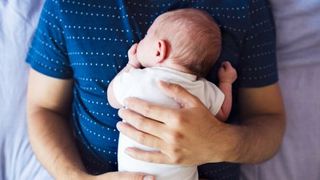What You Need To Know About Postnatal Depression In Men
How common are the baby blues in fathers and what can be done about them?

The first few weeks after you have a baby are a blur of activity, as you frantically try to learn everything you need to know to keep your child alive and happy. Or as happy as they can be when all they do is eat, sleep, cry and... you know.
It’s a knackering and yet magical period, but it’s also common to experience some form of the “baby blues”, where you feel low and unhappy.
Postnatal depression is believed to affect about one in ten women, with many more experiencing a milder case of the baby blues, with chemical and hormonal changes after birth a common cause.
Men don’t go through these same physical changes, but depression can still strike new fathers. As this year’s International Fathers’ Mental Health Day focuses on this issue, we spoke to Glenys Jackson, clinical lead for mental health at Bupa UK, to get more info on how to spot paternal depression, along with what you can do about it.
What is male postnatal depression?
The term is used to refer to a type of depression experienced by men at some stage after the birth of their child. The actual condition diagnosed is paternal postpartum depression [but] male postnatal depression is commonly used due to the widely established female version of the condition.
What are the symptoms?
In a similar way to mothers with postnatal depression, fathers suffering from the condition may feel extreme sadness following the birth of their child. They may constantly feel worry and fear over their competence as a parent. They can feel very physically and/or mentally tired and irritable, experiencing high stress levels and even intrusive, distressing thoughts about harming their child. They may feel completely unable to bond with their child and excluded from the family dynamic, perhaps even feeling irrational jealousy over the mother-child relationship.
How common is it?
Paternal postpartum depression has been stated in some studies to affect up to 10% of men around the world, though other research has shown the figure to be as high as 25% in the first two months from birth. It has been said that the numbers may well be higher, but due to the stigma around depression in men, many may not speak up and seek medical help. The figure is also said to be higher in those who have experienced past anxiety disorders.
Get the Coach Newsletter
Sign up for workout ideas, training advice, reviews of the latest gear and more.
See related
- How To Recognise Stress Drinking And What To Do About It
- This Ex-MMA Fighter Shows Therapy Isn’t Just For Those In Crisis
How long after birth can it appear?
Paternal postpartum depression can be experienced shortly after birth, with figures thought to then increase in the first two to three months. However, some studies suggest that postnatal depression develops more gradually in men than women, with men more commonly experiencing symptoms 12 months after birth. There is also evidence to suggest that around 5% of first-time fathers show signs of depression during pregnancy.
What can you do to treat it?
Speaking to a GP is highly recommended, as well as self-care such as talking to friends and family, getting enough rest and eating healthily. Anyone who notices the signs in their partner should encourage them to seek help, because trained professionals will be able to recognise the signs and prescribe treatment, or in more extreme cases antidepressants, as necessary.
Psychological treatments can include recommending self-help courses or referring therapy courses, such as cognitive behavioural therapy. Having an understanding place of work can be a huge relief – for example, offering shared parental leave can allow an effective amount of time for fathers to readjust to their new role, bond with their child and be able to commit to the daily care and routine.
If you think you may need help, the confidential Mind Infoline from mental health charity Mind is a good place to start

Nick Harris-Fry is a journalist who has been covering health and fitness since 2015. Nick is an avid runner, covering 70-110km a week, which gives him ample opportunity to test a wide range of running shoes and running gear. He is also the chief tester for fitness trackers and running watches, treadmills and exercise bikes, and workout headphones.
